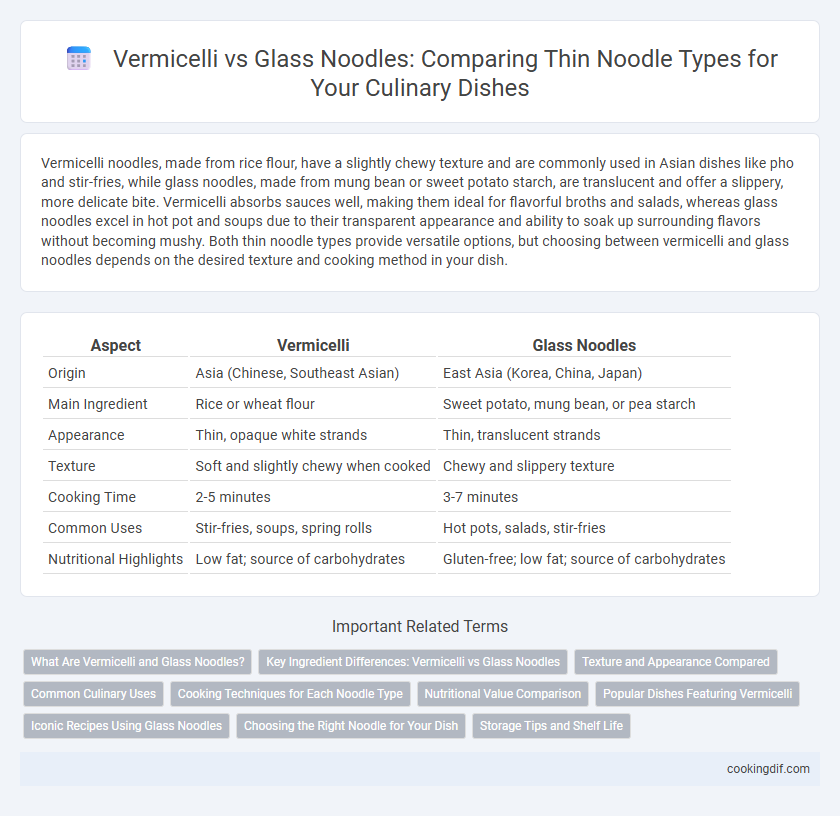Vermicelli noodles, made from rice flour, have a slightly chewy texture and are commonly used in Asian dishes like pho and stir-fries, while glass noodles, made from mung bean or sweet potato starch, are translucent and offer a slippery, more delicate bite. Vermicelli absorbs sauces well, making them ideal for flavorful broths and salads, whereas glass noodles excel in hot pot and soups due to their transparent appearance and ability to soak up surrounding flavors without becoming mushy. Both thin noodle types provide versatile options, but choosing between vermicelli and glass noodles depends on the desired texture and cooking method in your dish.
Table of Comparison
| Aspect | Vermicelli | Glass Noodles |
|---|---|---|
| Origin | Asia (Chinese, Southeast Asian) | East Asia (Korea, China, Japan) |
| Main Ingredient | Rice or wheat flour | Sweet potato, mung bean, or pea starch |
| Appearance | Thin, opaque white strands | Thin, translucent strands |
| Texture | Soft and slightly chewy when cooked | Chewy and slippery texture |
| Cooking Time | 2-5 minutes | 3-7 minutes |
| Common Uses | Stir-fries, soups, spring rolls | Hot pots, salads, stir-fries |
| Nutritional Highlights | Low fat; source of carbohydrates | Gluten-free; low fat; source of carbohydrates |
What Are Vermicelli and Glass Noodles?
Vermicelli are thin noodles made from rice or wheat flour, commonly used in Asian and Mediterranean cuisines for dishes like stir-fries and soups. Glass noodles, also known as cellophane noodles, are made from mung bean starch or sweet potato starch and turn translucent when cooked. Both noodle types differ in texture and cooking properties, with vermicelli being firmer and glass noodles offering a chewy, slippery consistency.
Key Ingredient Differences: Vermicelli vs Glass Noodles
Vermicelli noodles are primarily made from rice flour, giving them a slightly chewy texture and a mild, neutral flavor ideal for absorbing sauces. Glass noodles, also known as cellophane noodles, are made from mung bean starch or sweet potato starch, resulting in a translucent appearance and a slippery, gelatinous texture when cooked. The key ingredient differences directly impact cooking methods, texture, and dish compatibility in various Asian cuisines.
Texture and Appearance Compared
Vermicelli noodles are thin, cylindrical, and slightly opaque with a firm and springy texture, providing a chewy bite that holds sauces well. Glass noodles, also known as cellophane noodles, are translucent and slippery, boasting a softer and more delicate texture that absorbs flavors quickly. Visually, vermicelli appears more opaque and sturdy, while glass noodles shimmer with a glossy, glass-like appearance, making each ideal for different culinary presentations.
Common Culinary Uses
Vermicelli is commonly used in Asian dishes like stir-fries, soups, and spring rolls due to its quick cooking time and ability to absorb flavors. Glass noodles, made from mung bean starch, are popular in hot pots, salads, and Korean japchae for their translucent appearance and chewy texture. Both noodles complement light broths and vegetable-based dishes, enhancing texture without overpowering flavors.
Cooking Techniques for Each Noodle Type
Vermicelli noodles require brief boiling for 2-3 minutes or soaking in hot water until tender, then draining and rinsing under cold water to prevent overcooking and clumping. Glass noodles need soaking in warm water for 10-15 minutes or boiling for 1-2 minutes until translucent and soft, as prolonged cooking can cause them to become mushy. Proper cooking times and rinsing techniques maintain the delicate texture and prevent stickiness in both noodle types.
Nutritional Value Comparison
Vermicelli and glass noodles both serve as popular thin noodle options but differ nutritionally. Vermicelli, typically made from rice flour, offers moderate calories and carbohydrates while being low in fat and protein. Glass noodles, made from mung bean starch or sweet potato starch, generally provide fewer calories and are gluten-free but have less fiber and protein compared to vermicelli.
Popular Dishes Featuring Vermicelli
Vermicelli, a thin noodle made from rice or wheat flour, is celebrated in popular dishes like Vietnamese Pho, Singaporean Fried Vermicelli, and Malaysian Laksa due to its light texture and ability to absorb rich broths. Unlike glass noodles, made from mung bean starch or sweet potato starch, vermicelli offers a slightly firmer bite and a subtle flavor that complements diverse cuisines. Vermicelli's versatility enhances dishes ranging from stir-fries to soups, making it a staple in Southeast Asian culinary traditions.
Iconic Recipes Using Glass Noodles
Glass noodles, made from mung bean starch, offer a translucent, chewy texture distinct from the wheat-based, slightly firmer vermicelli noodles. Iconic recipes like Korean Japchae and Thai Yum Woon Sen showcase glass noodles' ability to absorb savory sauces and blend with stir-fried vegetables and proteins. Their gluten-free nature and unique elasticity make glass noodles a versatile ingredient in Asian cuisine, setting them apart from traditional vermicelli dishes.
Choosing the Right Noodle for Your Dish
Vermicelli noodles, made from rice flour, offer a slightly chewy texture ideal for stir-fries and salads, while glass noodles, derived from mung bean starch, provide a translucent appearance and a slippery, soft bite perfect for soups and hot pots. Selecting the right noodle depends on the desired dish texture and cooking method, as vermicelli absorbs sauces more readily, enhancing flavor density. For light, broth-based dishes, glass noodles maintain their shape without becoming mushy, making them a superior choice for clear soups and delicate recipes.
Storage Tips and Shelf Life
Vermicelli noodles, typically made from rice or mung bean starch, have a shelf life of up to one year when stored in a cool, dry place away from direct sunlight. Glass noodles, often made from mung bean or sweet potato starch, should be kept in airtight containers to prevent moisture absorption and can last up to 18 months under similar conditions. Proper storage for both noodle types extends freshness and prevents spoilage, ensuring optimal texture and flavor during cooking.
Vermicelli vs glass noodles for thin noodle types Infographic

 cookingdif.com
cookingdif.com